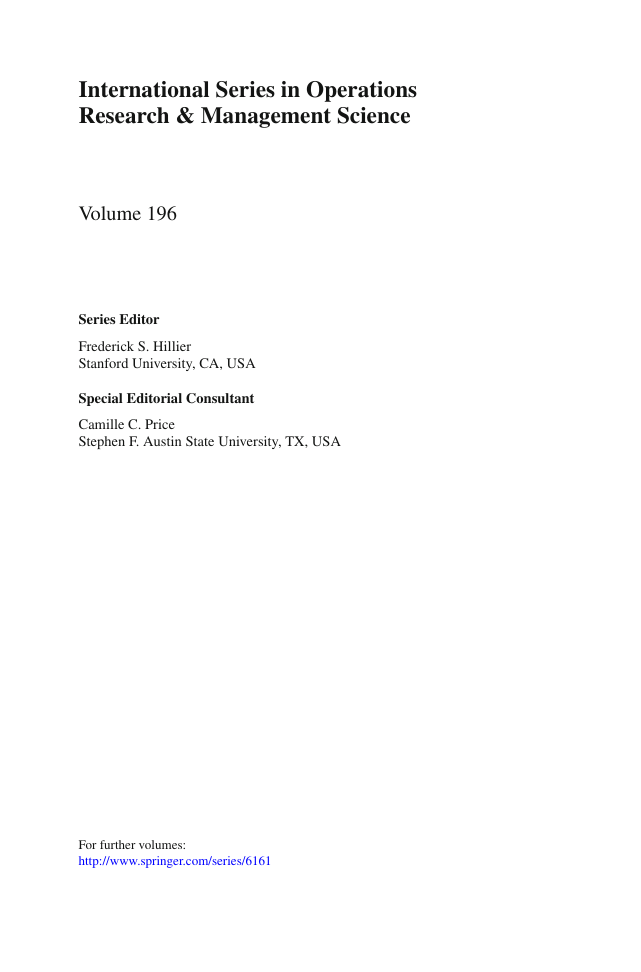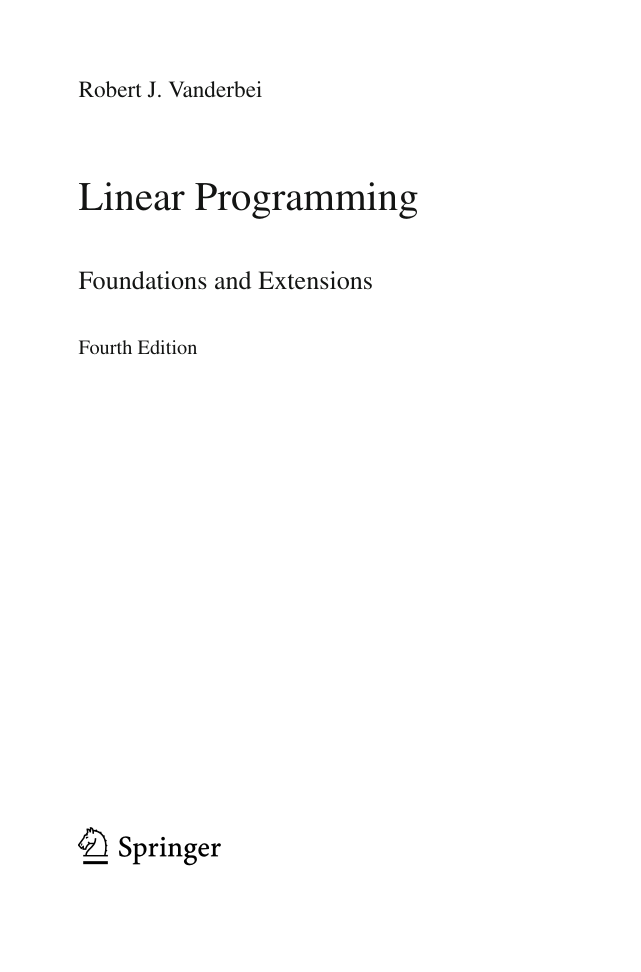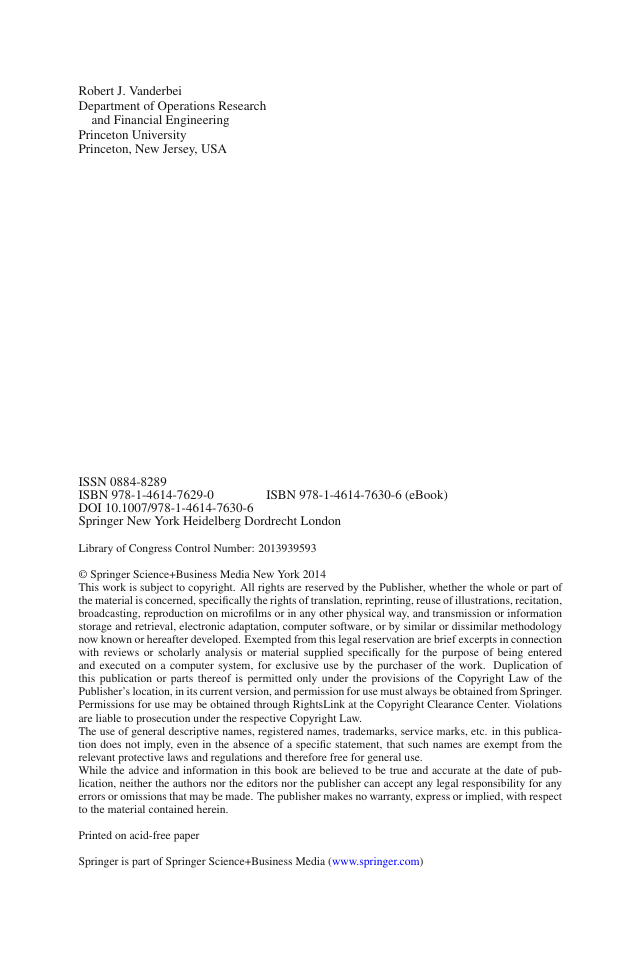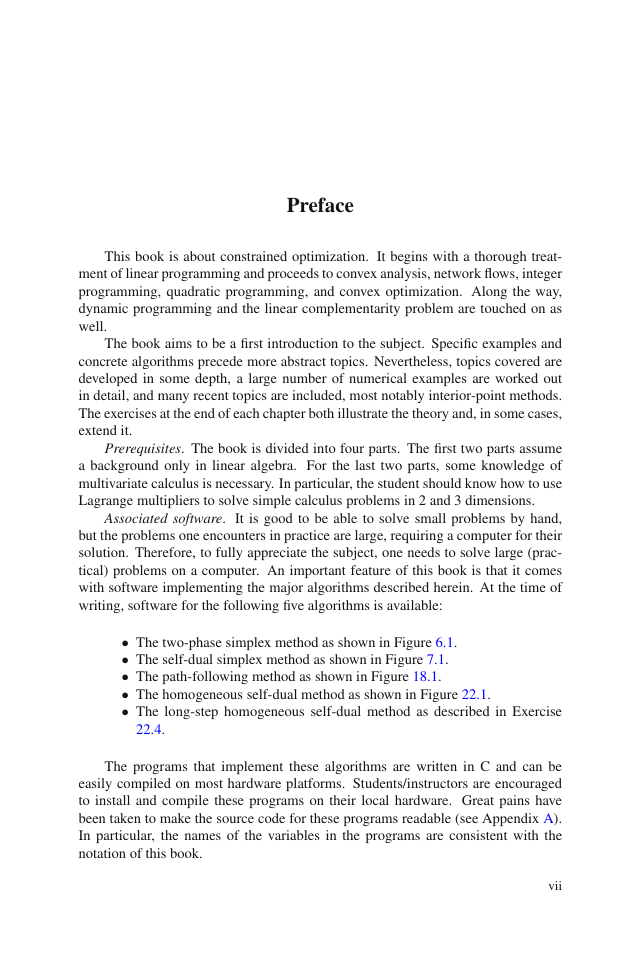Cover
Preface
Preface to 2nd Edition
Preface to 3rd Edition
Preface to 4th Edition
Contents
Part 1. Basic Theory: The Simplex Method and Duality
Chapter 1. Introduction
1. Managing a Production Facility
1.1. Production Manager as Optimist
1.2. Comptroller as Pessimist
2. The Linear Programming Problem
Exercises
Notes
Chapter 2. The Simplex Method
1. An Example
1.1. Dictionaries, Bases, Etc.
2. The Simplex Method
3. Initialization
4. Unboundedness
5. Geometry
Exercises
Notes
Chapter 3. Degeneracy
1. Definition of Degeneracy
2. Two Examples of Degenerate Problems
3. The Perturbation/Lexicographic Method
4. Bland's Rule
5. Fundamental Theorem of Linear Programming
6. Geometry
Exercises
Notes
Chapter 4. Efficiency of the Simplex Method
1. Performance Measures
2. Measuring the Size of a Problem
3. Measuring the Effort to Solve a Problem
4. Worst-Case Analysis of the Simplex Method
5. Empirical Average Performance of the Simplex Method
Exercises
Notes
Chapter 5. Duality Theory
1. Motivation: Finding Upper Bounds
2. The Dual Problem
3. The Weak Duality Theorem
4. The Strong Duality Theorem
5. Complementary Slackness
6. The Dual Simplex Method
7. A Dual-Based Phase I Algorithm
8. The Dual of a Problem in General Form
9. Resource Allocation Problems
10. Lagrangian Duality
Exercises
Notes
Chapter 6. The Simplex Method in Matrix Notation
1. Matrix Notation
2. The Primal Simplex Method
3. An Example
3.1. First Iteration
3.2. Second Iteration
3.3. Third Iteration
3.4. Fourth Iteration
4. The Dual Simplex Method
5. Two-Phase Methods
6. Negative Transpose Property
Exercises
Notes
Chapter 7. Sensitivity and Parametric Analyses
1. Sensitivity Analysis
1.1. Ranging
2. Parametric Analysis and the Homotopy Method
3. The Parametric Self-Dual Simplex Method
Exercises
Notes
Chapter 8. Implementation Issues
1. Solving Systems of Equations: LU-Factorization
2. Exploiting Sparsity
3. Reusing a Factorization
4. Performance Tradeoffs
5. Updating a Factorization
6. Shrinking the Bump
7. Partial Pricing
8. Steepest Edge
Exercises
Notes
Chapter 9. Problems in General Form
1. The Primal Simplex Method
2. The Dual Simplex Method
Exercises
Notes
Chapter 10. Convex Analysis
1. Convex Sets
2. Carathéodory's Theorem
3. The Separation Theorem
4. Farkas' Lemma
5. Strict Complementarity
Exercises
Notes
Chapter 11. Game Theory
1. Matrix Games
2. Optimal Strategies
3. The Minimax Theorem
4. Poker
Exercises
Notes
Chapter 12. Regression
1. Measures of Mediocrity
2. Multidimensional Measures: Regression Analysis
3. L2-Regression
4. L1-Regression
5. Iteratively Reweighted Least Squares
6. An Example: How Fast Is the Simplex Method?
6.1. Random Problems
Exercises
Notes
Chapter 13. Financial Applications
1. Portfolio Selection
1.1. Reduction to a Linear Programming Problem
1.2. Solution via Parametric Simplex Method
2. Option Pricing
Exercises
Notes
Part 2. Network-Type Problems
Chapter 14. Network Flow Problems
1. Networks
2. Spanning Trees and Bases
3. The Primal Network Simplex Method
4. The Dual Network Simplex Method
5. Putting It All Together
6. The Integrality Theorem
6.1. König's Theorem
Exercises
Notes
Chapter 15. Applications
1. The Transportation Problem
2. The Assignment Problem
3. The Shortest-Path Problem
3.1. Network Flow Formulation
3.2. A Label-Correcting Algorithm
3.2.1. Method of Successive Approximation
3.2.2. Efficiency
3.3. A Label-Setting Algorithm
4. Upper-Bounded Network Flow Problems
5. The Maximum-Flow Problem
Exercises
Notes
Chapter 16. Structural Optimization
1. An Example
2. Incidence Matrices
3. Stability
4. Conservation Laws
5. Minimum-Weight Structural Design
6. Anchors Away
Exercises
Notes
Part 3. Interior-Point Methods
Chapter 17. The Central Path
Warning: Nonstandard Notation Ahead
1. The Barrier Problem
2. Lagrange Multipliers
3. Lagrange Multipliers Applied to the Barrier Problem
4. Second-Order Information
5. Existence
Exercises
Notes
Chapter 18. A Path-Following Method
1. Computing Step Directions
2. Newton's Method
3. Estimating an Appropriate Value for the Barrier Parameter
4. Choosing the Step Length Parameter
5. Convergence Analysis
5.1. Measures of Progress
5.2. Progress in One Iteration
5.3. Stopping Rule
5.4. Progress Over Several Iterations
Exercises
Notes
Chapter 19. The KKT System
1. The Reduced KKT System
2. The Normal Equations
3. Step Direction Decomposition
Exercises
Notes
Chapter 20. Implementation Issues for Interior-Point Methods
1. Factoring Positive Definite Matrices
1.1. Stability
2. Quasidefinite Matrices
2.1. Instability
3. Problems in General Form
Exercises
Notes
Chapter 21. The Affine-Scaling Method
1. The Steepest Ascent Direction
2. The Projected Gradient Direction
3. The Projected Gradient Direction with Scaling
4. Convergence
5. Feasibility Direction
6. Problems in Standard Form
Exercises
Notes
Chapter 22. The Homogeneous Self-Dual Method
1. From Standard Form to Self-Dual Form
2. Homogeneous Self-Dual Problems
2.1. Step Directions
2.2. Predictor-Corrector Algorithm
2.3. Convergence Analysis
2.4. Complexity of the Predictor-Corrector Algorithm
2.5. The KKT System
3. Back to Standard Form
3.1. The Reduced KKT System
4. Simplex Method vs. Interior-Point Methods
Exercises
Notes
Part 4. Extensions
Chapter 23. Integer Programming
1. Scheduling Problems
2. The Traveling Salesman Problem
3. Fixed Costs
4. Nonlinear Objective Functions
5. Branch-and-Bound
Exercises
Notes
Chapter 24. Quadratic Programming
1. The Markowitz Model
2. The Dual
3. Convexity and Complexity
4. Solution via Interior-Point Methods
5. Practical Considerations
Exercises
Notes
Chapter 25. Convex Programming
1. Differentiable Functions and Taylor Approximations
2. Convex and Concave Functions
3. Problem Formulation
4. Solution via Interior-Point Methods
5. Successive Quadratic Approximations
6. Merit Functions
7. Parting Words
Exercises
Notes
Appendix A. Source Listings
1. The Self-Dual Simplex Method
2. The Homogeneous Self-Dual Method
Answers to Selected Exercises
Bibliography
Index
















 2023年江西萍乡中考道德与法治真题及答案.doc
2023年江西萍乡中考道德与法治真题及答案.doc 2012年重庆南川中考生物真题及答案.doc
2012年重庆南川中考生物真题及答案.doc 2013年江西师范大学地理学综合及文艺理论基础考研真题.doc
2013年江西师范大学地理学综合及文艺理论基础考研真题.doc 2020年四川甘孜小升初语文真题及答案I卷.doc
2020年四川甘孜小升初语文真题及答案I卷.doc 2020年注册岩土工程师专业基础考试真题及答案.doc
2020年注册岩土工程师专业基础考试真题及答案.doc 2023-2024学年福建省厦门市九年级上学期数学月考试题及答案.doc
2023-2024学年福建省厦门市九年级上学期数学月考试题及答案.doc 2021-2022学年辽宁省沈阳市大东区九年级上学期语文期末试题及答案.doc
2021-2022学年辽宁省沈阳市大东区九年级上学期语文期末试题及答案.doc 2022-2023学年北京东城区初三第一学期物理期末试卷及答案.doc
2022-2023学年北京东城区初三第一学期物理期末试卷及答案.doc 2018上半年江西教师资格初中地理学科知识与教学能力真题及答案.doc
2018上半年江西教师资格初中地理学科知识与教学能力真题及答案.doc 2012年河北国家公务员申论考试真题及答案-省级.doc
2012年河北国家公务员申论考试真题及答案-省级.doc 2020-2021学年江苏省扬州市江都区邵樊片九年级上学期数学第一次质量检测试题及答案.doc
2020-2021学年江苏省扬州市江都区邵樊片九年级上学期数学第一次质量检测试题及答案.doc 2022下半年黑龙江教师资格证中学综合素质真题及答案.doc
2022下半年黑龙江教师资格证中学综合素质真题及答案.doc